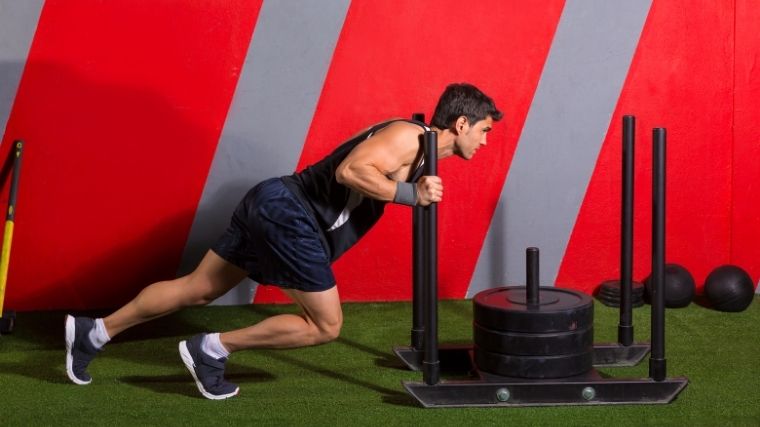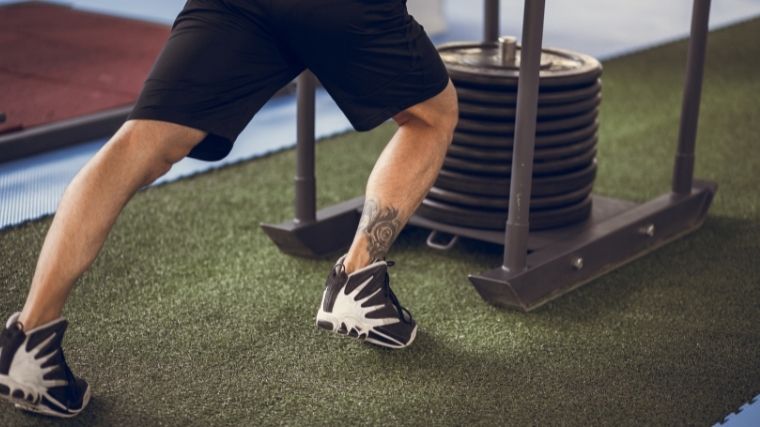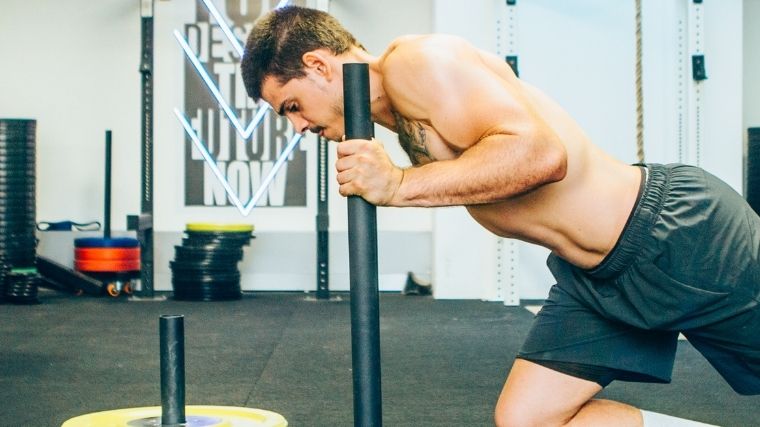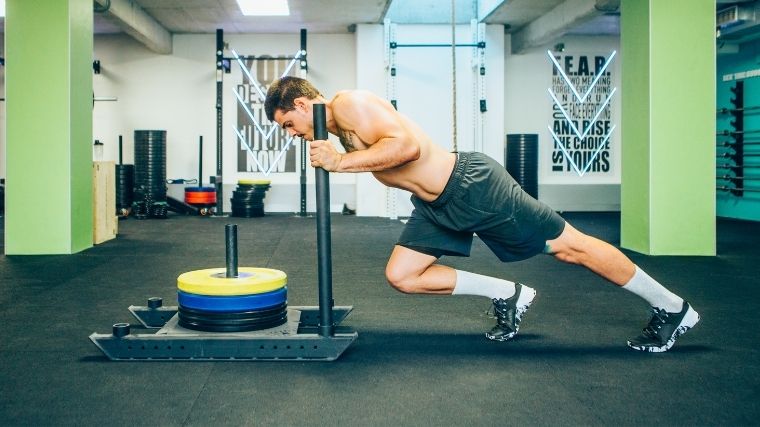Here’s an unpopular opinion: The sled push is as effective for building leg muscle and strength as the deadlift and squat. Hear us out before you, and your mob of gym bros come at us. The secret sauce lies in how the sled push loads your body — much more tenderly than the deadlift and squat.

The sled push doesn’t require you to hoist hundreds of pounds on your spine compared to many heavy compound movements. Instead, you angle your body diagonally and drive the weight using your legs as the main driver. Will you become a world-class powerlifter from using the sled push alone? No. But will you develop powerful leg drive and more leg muscle in the process? Yes. Of course, you first need to learn how to push a sled before you can expect stellar results properly. Allow us to help.
- How to Do the Sled Push
- Benefits of the Sled Push
- Muscles Worked by the Sled Push
- Who Should Do the Sled Push
- Sled Push Sets and Reps
- Sled Push Variations
- Sled Push Alternatives
- Frequently Asked Questions
How to Do the Sled Push
To perform the sled push, you need a sled, a non-friction surface like turf or smooth flooring that won’t scratch, and weight plates. In the below section, we will discuss how to do the sled push.
Step 1 — Load a Sled with Weight

The logistics of this step couldn’t be more simple: Place weight plates on the center of your sled. Depending on your model, the sleeve may be located in the center or on the sides. Also, be mindful of the surface you’re pushing the sled on. Turf will be easier than a parking lot. Over time, you’ll better understand how much weight you can push on any surface; be sure to adjust accordingly.
Coach’s Tip: Be wary of the amount of weight you’re using relative to your goals. If you’re looking to get stronger, load up the plates and be prepared to push the sled at a slow pace. If speed and power are what you desire, reduce the load and sprint as fast as possible.
Step 2 — Grip the Sled

Place the hands about halfway down the sled handles. Assume a staggered stance, and lean forward so that your spine is parallel to the ground and your lower back is flat. Your hips should be slightly elevated, and your elbows bent, so your shoulders are almost touching the handles.
Coach’s Tip: Get your torso as close to parallel to the ground as possible to get the best angle on the sled. The more upright you are, the more you are working against the friction and making the sled not as effective at moving.
Step 3 — Drive, Drive, Drive

Keep your arms locked and begin aggressively driving forward with your legs. Maintain a forward lean and push through the balls of your feet.
Coach’s Tip: If your arms are extended, you may be able to use more weight and engage the shoulders and upper back. Bending your arms will place more tension on the legs, as you’re disengaging your upper body, however, it may cause some discomfort to your elbows and shoulders.
Benefits of the Sled Push
The sled offers numerous benefits for lifters and athletes of all skill levels, and is 100% reliant on the loading, intensity, and duration of the push.
The sled push can facilitate strength gains and bolstered conditioning. Below are three primary benefits of the sled push.
Side-to-Side Gains
When you think of unilateral training, you think of single-arm dumbbell presses and lunges, but the sled may be one of the most functional unilateral training tools on the market.
Every step you takes places you on one leg, so, technically speaking, you’re training your legs to power you forward under load. The difference between this movement the squat, is that your legs are working, and being strengthened, how they function — one is propelling you forward as the other is grounded. It doesn’t get more “functional” than that.
[RELATED: Best Leg Workouts]
Lower Body Strength and Hypertrophy
The sled push can be used to build leg strength and muscle hypertrophy. To build strength, you can do heavy sled pushes with max effort loads for 20-30 seconds, which can help build unilateral leg and hip strength. You can also build muscle when doing the same sled pushes or even extending the sled push duration of 45-90 seconds.
You shouldn’t do away with more traditional strength-building movements. Instead, use the sled as an accessory to your training; it’s a more joint-friendly option, preventing an accumulation of stress to take its toll on your body during hard training cycles.
It’s More Back-Friendly
There’s a reason lifters everywhere choose back squats and deadlifts as their main strength-building movements — they work. That said, heavy deadlifts can cause excessive spinal flexion and heavy back squats can compress the spine. Over time, enough heavy squats and poorly executed deadlifts have the potential to lead to injury.
The sled instead places most of the onus on the legs. This isn’t to say the back musculature isn’t engaged to some degree — it is — but the user doesn’t have to subject their spine to hundreds of pounds. Another benefit of the sled is that, like the deadlift, if the load is too great, then the user simply won’t be able to move it — no harm no foul.
Muscles Worked by the Sled Push
The sled push is a dynamic movement that primarily trains the lower body, especially the glutes, quadriceps, and calves.
Glutes
The glutes take on a fair share of the movement as they are needed to provide support while extending the knees and hips (stability). The glutes are also the main muscle used to have a powerful leg extension, especially at the hip joint.
Quadriceps
The quadriceps extend the knee joint, so they’re naturally active during every step of the sled push. As you push the sled, your knees go into flexion as you step forward, and extend as you drive off the leg, creating massive amounts of muscular tension in the quadriceps.
Calves
The sled push can be a calf-builder, especially when done with heavy loads. While there is not a ton of eccentric loading (a key aspect of muscle growth), the sled push allows you to get high amounts of force output through the calf with every step, especially under heavy loads. The tension is almost alway on the muscle, as your footing is key during the sled push, increasing the time under tension as well. Lastly, you are often able to perform sled pushes many times a week, increasing the training frequency of the calf muscles which can also boost muscle growth.
Who Should Do the Sled Push
Whether you are going after a 500-pound back squat, running half marathons, or recovering from injury, the sled push is something that should find its way into every program.
Strength and Power Athletes
As discussed above, the sled push can be used to increase leg strength, speed, and muscle growth. A benefit of the sled push is that is often does not conflict with main strength-building movements such as squats and deadlifts, and can often help improve blood flow, alleviate stress on the lower back, and allow you to stimulate the lower body more frequently without beating the body up (something that is challenging for strength and power athletes).
[Read More: Best Lower Back Exercises for Strength and Reduced Pain]
Powerlifters, strength sport athletes, and weightlifters alike can benefit from adding these into warm-ups, accessory training, conditioning, and even light active recovery sessions.
Endurance Athletes
Endurance athletes, like marathon runners, stand to benefit in the same way a strength athlete does but for different reasons. Consistent running can be extremely taxing on the knees, especially if you’re typically pounding pavement and hard earth. As such, the sled push may serve to help improve a runner’s conditioning and endurance without the knee impact.
A runner needs to run, of course, but supplementing a few miles for low-impact, low-weight sled work serves to offer a unique stimulus. That is, runners will gain strength by pushing a weighted sled, therefore reinforcing the susceptible knee joint, while still improving their cardiovascular ability.
Sled Push Sets and Reps
When programming sled pushes, the sets, reps, and loading schemes can vary dramatically based on the training goal. Below, we will discuss some of the most common uses for the sled push in training and offer some guidelines on how to best program these into your workouts.
To Build Strength
Aim to push a sled for eight sets of 20-30-second intervals. Use just a tad less than your max load for a 20-to-30 second push. (You want to compensate for fatigue over the course of eight sets.) Rest as long as you need between sets.
To Build Muscle
Time under tension is the name of the game here. Perform four to six sets of 45-90-second pushes. Again, load the sled with as much weight as you can handle for your longest push, but factor in the fact that you’ll be doing six sets at most.
To Get Faster
To get faster, you need to move fast. The weight on the sled should still allow you to run close to or at the same speeds as if you weren’t using weights. When in doubt, use less weight and sprint harder.
- For short distances: Do 20-40-meter sprints (5-10 seconds of work), with rest periods of 45-60 seconds.
- For medium distances: Sprint while pushing a sled about 50-100 meters (10-20 seconds), then rest 90-120 seconds.
- For longer distances: Do 100-400-meter sled sprints (30-60 seconds), then rest 2-3 minutes.
Sled Push Variations
The sled push is a movement that delivers immense benefits for anyone who does them with intensity and effort. When looking to do a sled push variation, you may find it more beneficial to do the standard sled push and just push harder, run faster, or do more volume. Finding fancy variations may seem “fun or challenging,” but the complexity of the standard sled push may actually detract from your ability to pour all of your effort and energy into something (which is what truly creates results).
If you are still looking for a variation that can offer benefits and let you really attack your training, look no further than the sled drag.
Sled Drag
The sled drag is a variation in which you walk backwards and pull the sled by holding onto straps. (You can also use a belt attachment so the weight is secured around your waist.
You want to make sure you do not just pull on the handles, but rather find some straps that allow you to sit in a half-squat position with an upright torso. This will target the quadriceps, and is a great way to also bolster knee health.
Sled Push Alternatives
The sled push is one of those exercises that is the complete package. It works great, and often doesn’t need to be tweaked. That said, you may find yourself without a sled, however you can use the below sled push alternative to get a similar stimulus to the standard sled push and keep your training going.
Plate Push
The plate push is an effective way to simulate the sled push if you don’t have access to a sled. Simply place a large, folded towel on a wood floor and stack a plate or two on top. Or, place a bumper plate on smooth turf. Bend over and push.
The plate push is limited in the fact that it places you in an awkward, too-low pushing position. Think of it as a watered-down version of the sled push. You won’t be able to push as much weight or go as fast, but it”s a great alternative if you don’t have other options.
Treadmill Push
The treadmill push is a great variation to the sled push, as it doesn’t distort your running form and allows you to push the belt with intensity. To perform the treadmill push, stand on a a powered-off electric treadmill, hold the handles, and drive the belt with your legs.
Note: some gyms do not allow this as it can cause some extra wear and tear to the machines, so make sure you check first to see if it’s ok to do. It’s not worth getting kicked out or making an enemy of the gym owner. If they say no, you can always flip the script and (politely) suggest that they invest in a sled.
Banded Sprint
The banded sprint is a way to train for speed and power without a sled. All you need to do is loop a resistance band around your waist, and have a partner or coach hold it and stand behind you.
[Read More: The Best Quad Exercises and Quad Workouts for Muscle Gain]
As you run, you will have drag and resistance behind you from the band. These are great for short bursts and acceleration training, but you can also do this with two people and take turns doing short bursts as you run continuously (the person in the back gets to take a slight rest as they try to hold you back).
Final Word
The sled push is a wonderful exercise to build stronger legs, increase muscle mass, and add training volume for any goal. The ability to lay the legs without adding a ton of stress to the lower back or joints makes this a great movement to add into programs for any level or ability.
FAQs
The sled push is a straightforward exercise, however some lifters may need some more answers to common questions that pop up from time to time regarding the sled push.
How heavy should I train the sled push?
Depending on the goal, the loading will vary. Refer to the sets and reps section above. If you want to get strong, load it up with as much weight as you can push. Max it out!
Can beginners do sled pushes?
Yes, the sled push is a great beginner exercise to build leg strength, muscle mass, and work capacity. It doesn’t replace other leg exercises, but it is a great addition to any program.
How often can I do sled pushes?
You can do these as much as you would like (or as much as you can stomach). The sled push has little eccentric loading, making it great for recovery days, strength building, and overall fitness any day of the week.
Featured Image: lunamarina/Shutterstock